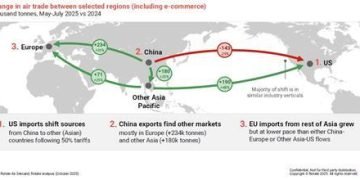By The Logistic News – November 13, 2025
The running starts to feel different for air cargo. Gone are the blistering growth years when freight rates soared and every wide-body freighter ran full. Now, as we head into 2026, the mood is more subdued — but far from pessimistic.
Analysts at consulting firm Rotate describe the market as one entering a phase of normalisation. Growth in volume is expected to be modest, constrained by high interest rates, softer consumer spending and ongoing political frictions across major trade corridors. Add to that the return of belly-hold capacity from passenger aircraft, and the result is pressure on yields and more selective deployment of freighters.
Yet Rotate is clear: this is not the end of air cargo’s role. Inventory levels in major economies such as North America and Europe remain beneath their pre-pandemic norms. For key sectors — think tech, e-commerce and healthcare — speed still matters. Companies launching new products, building data-centres or shipping critical medical components won’t suddenly trade 14-hour flights for 40-day sailings overnight.
Freighter utilisation remains at near-record levels. Carriers and integrators are shifting strategy: no longer chasing every tonne, they are focusing on profitable corridors, data-led demand forecasting and flexible capacity swaps. Forwarders too are adapting: long-term block-space deals replace pure spot bookings, building more resilience into contracts.
For shippers, the message is clear: 2026 won’t bring wild rate spikes, but it also won’t be a struggle to fill freighters. It will be a test of intelligence, discipline and flexibility. The explosion years are behind us, but for those who plan well, the air cargo business still has ample upside.






















